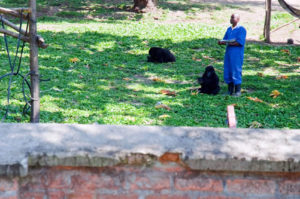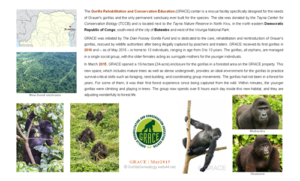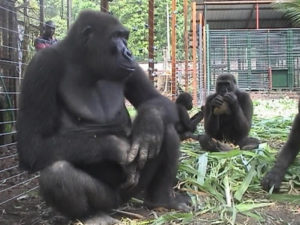Are you looking for information about donating and adopting gorillas in Uganda, Congo and Rwanda? Read on!! Gorillas are arguably the most fascinating primates. There are two main species of gorillas – The Eastern and Western gorilla. The Eastern Gorilla is further divided into the Mountain gorilla and the Eastern lowland gorilla. The Western Gorilla is divided into two subspecies – The Cross River Gorilla and the Western lowland gorilla. Mountain gorillas are only found in Uganda, Rwanda and the Democratic Republic of Congo. The Eastern lowland gorilla can only be found in the Democratic Republic of Congo.
Western lowland gorillas are the most numerous with a population of over 250,000. They roam the forests of Central and west Africa. Cross river Gorillas are only found in Cameroon and Nigeria and are the most threatened of all the gorilla sub-species. Only about 300 Cross River Gorillas remain in the wild. They are followed closely by the mountain gorillas whose numbers just reached 1,000 in the 2018 mountain gorilla census. The number of Eastern lowland gorillas continues to go down due to habitat loss, poaching and pet trade. Only about 7,000 Eastern lowland gorillas remain in the wild.
Adopting a Gorilla as a gorilla conservation tool
Because most of the gorilla sub-species are threatened, the IUCN has put mountain gorillas, Cross River Gorillas and Eastern lowland gorillas on their Red list of critically endangered species. As already mentioned earlier, gorillas face a great threat from poachers, habitat loss, new and unfamiliar diseases resulting from more frequent contact with humans.
 Several organizations have pulled together resources to help protect the gorillas. Some of the international gorilla conservation organizations include the Gorilla Doctors, Dian Fossey Gorilla Fund international, The mountain Gorilla Conservation Fund, International Gorilla Conservation programme and Conservation through Public Health. They all work closely with local government authorities to protect the primates through community sensitization, offering veterinary services, building infrastructure, organizing censuses and carrying out research.
Several organizations have pulled together resources to help protect the gorillas. Some of the international gorilla conservation organizations include the Gorilla Doctors, Dian Fossey Gorilla Fund international, The mountain Gorilla Conservation Fund, International Gorilla Conservation programme and Conservation through Public Health. They all work closely with local government authorities to protect the primates through community sensitization, offering veterinary services, building infrastructure, organizing censuses and carrying out research.
The Senkwekwe Centre and The Gorilla Rehabilitation and Conservation Education (GRACE) Centre
In order to protect the primates, gorilla conservation organizations like the Gorilla Doctors help treat orphaned gorillas whose parents were killed by poachers and animal traffickers. Gorillas will protect their young to the death. To Capture a baby gorilla, a poacher or animal trafficker may need to kill the entire group.
 The Senkwekwe Centre in the Democratic Republic of Congo is an excellent example of a great gorilla conservation initiatives in Africa. The Centre confiscates orphaned gorillas from animal traffickers and poachers and takes them to the extensive care facility for proper monitoring by the Gorilla Doctors. The Senkwekwe Centre is the only mountain gorilla orphanage in the world. Most of the young gorillas arrive when they are traumatized not only because of the poor conditions they are found in but also as a result of watching most of their family members and parents killed. Some arrive at the Centre with bullet or snare wounds while others arrive malnourished. The Centre employs dedicated Caregivers and a team of veterinary specialists who take care of the primates until they recover from their trauma and wounds. Although the intention of the facility is to reintroduce them back into the wild, it is hard to see the orphans adapting to life with a new wild gorilla group. Their chances of survival away from the special treatment at the Centre is difficult to predict. For that reason, most will probably remain at the facility for the rest of their lives. The Centre also receives a few Eastern lowland gorilla orphans from time to time.
The Senkwekwe Centre in the Democratic Republic of Congo is an excellent example of a great gorilla conservation initiatives in Africa. The Centre confiscates orphaned gorillas from animal traffickers and poachers and takes them to the extensive care facility for proper monitoring by the Gorilla Doctors. The Senkwekwe Centre is the only mountain gorilla orphanage in the world. Most of the young gorillas arrive when they are traumatized not only because of the poor conditions they are found in but also as a result of watching most of their family members and parents killed. Some arrive at the Centre with bullet or snare wounds while others arrive malnourished. The Centre employs dedicated Caregivers and a team of veterinary specialists who take care of the primates until they recover from their trauma and wounds. Although the intention of the facility is to reintroduce them back into the wild, it is hard to see the orphans adapting to life with a new wild gorilla group. Their chances of survival away from the special treatment at the Centre is difficult to predict. For that reason, most will probably remain at the facility for the rest of their lives. The Centre also receives a few Eastern lowland gorilla orphans from time to time.
 If you are interested in a similar facility for Eastern Lowland Gorillas then you should read more about the GRACE Gorilla Rehabilitation and Conservation Education Centre. This Centre is based in Kasugho (Democratic Republic of Congo) and is similar to the Senkwekwe Centre but receives Eastern Lowland Gorilla orphans (Grauer’s gorillas). The most famous Eastern lowland gorilla orphan is Kalonge. She was first raised at the Senkwekwe Gorilla orphanage before being transferred to the GRACE Centre. The Senkwekwe and GRACE Centre’s offer individuals an opportunity to volunteer or make a donation to the facility. A more interesting alternative is the opportunity to adopt a specific orphaned gorilla.
If you are interested in a similar facility for Eastern Lowland Gorillas then you should read more about the GRACE Gorilla Rehabilitation and Conservation Education Centre. This Centre is based in Kasugho (Democratic Republic of Congo) and is similar to the Senkwekwe Centre but receives Eastern Lowland Gorilla orphans (Grauer’s gorillas). The most famous Eastern lowland gorilla orphan is Kalonge. She was first raised at the Senkwekwe Gorilla orphanage before being transferred to the GRACE Centre. The Senkwekwe and GRACE Centre’s offer individuals an opportunity to volunteer or make a donation to the facility. A more interesting alternative is the opportunity to adopt a specific orphaned gorilla.
Why you should adopt a Gorilla
Gorilla trekking is a good way of indirectly contributing to gorilla conservations programs but it is not enough. The great primatologist Dian Fossey is remembered for initiating several gorilla conservation activities and programs. Fossey studied mountain gorillas extensively but later changed to active participation in eliminating poaching and gorilla trafficking. She campaigned against poachers relentlessly and let the world know about the plight of mountain gorillas in East and Central Africa. Dian Fossey’s efforts led to wider recognition of the need to stop poaching and allocate more funds to gorilla conservation efforts. After her death, her work continued through the Dian Fossey Gorilla Fund International. The Fund helps protect gorillas and sensitizes communities living close to gorilla habitats on how to live harmoniously with the primates. The organization allows individuals, groups and organizations to adopt or sponsor a gorilla.
 Adopting a gorilla is important because it allows individuals to partner with organizations in protecting the endangered primates. Gorilla conservation is more effective when individuals join hands with organizations for the same goal of eliminating poaching, illegal animal trafficking and habitat loss. The number of mountain gorillas has now risen to slightly over 1,000 individuals. This is a result of the tireless work of gorilla conservation organizations and government agencies. These organizations receive funding from both government and individual donors. By donating to organizations like the Dian Fossey Foundation, Senkwekwe Centre or the Gorilla Doctors, you help ensure that gorilla numbers remain high and that they are always protected. Donations and sponsoring individual gorillas helps ensure that they receive the best possible care.
Adopting a gorilla is important because it allows individuals to partner with organizations in protecting the endangered primates. Gorilla conservation is more effective when individuals join hands with organizations for the same goal of eliminating poaching, illegal animal trafficking and habitat loss. The number of mountain gorillas has now risen to slightly over 1,000 individuals. This is a result of the tireless work of gorilla conservation organizations and government agencies. These organizations receive funding from both government and individual donors. By donating to organizations like the Dian Fossey Foundation, Senkwekwe Centre or the Gorilla Doctors, you help ensure that gorilla numbers remain high and that they are always protected. Donations and sponsoring individual gorillas helps ensure that they receive the best possible care.
How do I adopt a baby gorilla?
The Senkwekwe Centre and other similar facilities allow individuals and groups to adopt gorillas. These donations help offset some of the costs of hiring staff and food for the orphans. The donations can also be used for building infrastructure at the sanctuaries and sensitizing local communities about the importance of wildlife conservation.
Adopting a gorilla at the Senkwekwe Centre
The Senkwekwe Centre currently accepts donations from individuals who are willing to adopt a particular mountain gorilla in the facility. The cost of caring for baby gorillas is expensive. Formular for a baby gorilla can cost $480 in a year. The food for adult gorillas is even more expensive and can go up to $1200 a year while the Caretakers need salaries of about $5,400 each year. Maintaining the facilities at the Centre costs about $12,000 per year. The Centre has received generous contributions from individuals and organizations but there are still costs to cover. You can support the Centre by adopting one of the mountain gorillas like Musuka (formerly known as Yalala), Matabishi, Ndeze and Ndakasi. To donate or adopt a gorilla, you need visit the Gorilla Doctors website for information about how to donate to a particular gorilla at the Senkwekwe Centre.
Other Organizations offering opportunities to adopt a gorilla
If you are interested in organizations similar to the Senkwekwe and GRACE Centre, then the Kagwene Gorilla Sanctuary and Limbe Wildlife Centre for Cross River gorillas in Cameroon would be an excellent. If you are interested in sponsoring or donating to a gorilla through an organization, then you should check Nature’s Path donations to the Dian Fossey Foundation, The Smithsonian’s National Zoo, The Aspinall Foundation, World Wildlife Fund, Conservation Biology Institute, the World Animal Foundation or the Dian Fossey Foundation website.
If you are interested in sponsoring zoo animals, then you should find out about the opportunities available at the Woodland Park Zoo, Philadelphia zoo, The Paignton Zoo, the Lincoln Park Zoo, The Fort Worth Zoo and the Francisco Zoological Society. The Bristol Zoo also offers individuals opportunities to sponsor Western lowland gorillas like Jock the Silverback.
What is the reward for donating to gorilla conservation?
Is there a reward or recognition for sponsoring a gorilla? Donors shouldn’t expect a reward for sponsoring a gorilla. The only true reward is knowing that you have made your contribution to the protection and conservation of one of man’s closest relatives. That side, most organizations that accept donations usually have package for sponsors. Most offer certificates, information about the gorilla you are sponsoring, photos and a thank you letter. If you are sponsoring a gorilla in a zoo, you might have your names displayed. The Bristol zoo provides donors with free tickets to the zoo, a toy, a certificate and their names displayed at the gorilla enclosure. The World Animal Foundation Gorilla Sponsorship kit comes with a photo of the adopted gorilla, a certificate and a card containing information about wildlife conservation. Apart from the packages already mentioned, The Dian Fossey Gorilla Fund International allows donors free subscription to their quarterly newsletter and a special video of the gorilla you would be adopting.
Note: The organizations we mention in this article are all credible and will ensure that every penny is used to improve the lives of the primates.


Hello. How can I donate?
Where would the gorilla live if adopted? In the house or still in the center? That is my biggest curiosity.